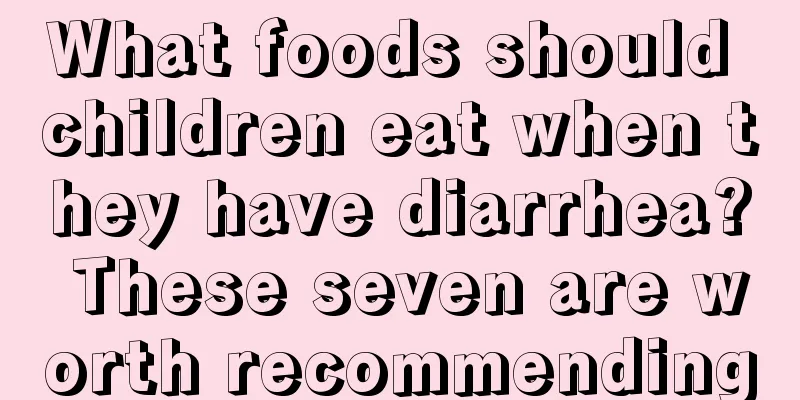Breastfed baby's stool is yellow with green

|
For many parents, it is actually very difficult to judge whether there is a health problem with the child based on the baby's stool. When the baby's stool is yellow with green, we are either shocked or we don't take it seriously at all. In fact, when the baby's stool is yellow with green, parents must pay attention, because this may indicate that the baby has health problems.
1. Newborn meconium (dark green) (1) Even if a newborn baby has not eaten anything, it will pass dark green meconium 6 to 12 hours after birth. (2) I don’t know whether the babies are considerate of their mothers or they don’t want to dirty the amniotic fluid they swallow every day, but the babies will not poop for the first time until they come out of their mother’s belly. Meconium that has accumulated for 9 months must be cleared out through frequent bowel movements, which usually takes 2 to 3 days, 3 to 5 times a day, for the dark green color to disappear. (3) Meconium is usually odorless, viscous, and dark green in color. It is mainly composed of amniotic fluid swallowed by the baby in the womb, epithelial cells shed by the fetus, vellus hair, sebum, bile, intestinal secretions, etc. These innate things are difficult to wash off, and experienced elders will tell the children's parents that they must use diapers instead of cloth diapers in the first few days. (4) Experts remind us that this is not a bad thing: the time for premature babies to pass meconium is sometimes delayed. This is mainly related to the poor intestinal motility of premature babies or delayed feeding of the children. 2. Transitional stool (yellow-green) (1) During the days when meconium is excreted, breastfeeding should also begin. When the meconium is completely excreted and the stool is transitioning to normal stool, it will be yellow-green in color. Most newborns' stools will show this stage after 2-3 days of breastfeeding, and then gradually enter the normal yellow stage (breastfed babies). (2) Experts remind us that this is not a bad "stool": the time when newborns start feeding and the amount of milk they consume will directly affect the appearance and duration of transitional stools. If the start of breastfeeding is delayed or the amount of milk consumed is too little, the transition period will also be delayed.
(1) Breastfed babies (soft golden stools) A. Breast milk is rich in oligosaccharides, which can fully stimulate gastrointestinal motility. Therefore, most babies will not have hard stools and no obvious odor. The stools are golden yellow, occasionally slightly green and relatively thin; or ointment-like, uniform, sour and without foam. The frequency of bowel movements of breastfed babies is very flexible. Usually, the frequency is higher in the neonatal period, 2 to 5 times a day. As the child grows older, the frequency of bowel movements will gradually decrease. For children aged 2 to 3 months, the frequency of bowel movements will be reduced to 1 to 2 times a day. Therefore, if a breastfed baby has loose stools or has more frequent bowel movements, it is normal as long as the baby is in good spirits and feeding, has normal weight gain, and does not have difficulty defecating, abdominal pain, or bloating, and parents do not need to worry. B. Experts remind that this is not a bad "poop": Breastfed newborns may even defecate 7 to 8 times a day. Parents do not need to worry. This is called physiological diarrhea, which is a normal phenomenon. When the baby grows to a certain age, this diarrhea will disappear automatically. (2) Artificially fed babies (khaki-yellow hard stools)A. Babies fed with formula have less stool, which is usually drier, rougher, and a little harder like paste. But as long as it is not difficult to pass and does not resemble sheep feces, it is fine. If there is no problem with digestion, it will usually be earthy yellow or golden yellow with a slightly sour smell, about 1 to 2 times a day. B. Experts remind that this is not a bad "stool": Babies who drink formula milk sometimes have yellow stools with green or cyan. This is because the iron content in formula milk is very high. When the baby does not fully absorb the iron in the milk powder, the excess iron will make the stool green. This is normal. It is not true what the older generation says that children’s stools are green. It is gastrointestinal discomfort caused by being frightened. Abnormal bowel movements in infants 1 Once you are familiar with the normal "smell" of your baby as mentioned above, it will be easy to identify abnormal stools. In general, changes in the frequency and color of bowel movements do not indicate any problems, but the odor and water content of the stool may indicate many problems, such as the following bad "stinks" that hide hidden dangers and indicate disease. 2 Abnormal amniotic fluid in the mother's belly: (1) Ultrasound showed that the amniotic fluid in the mother's abdomen was turbid, and sampling showed the presence of turbid bodies. This means that the fetus has excreted meconium into the amniotic fluid, which is not a good thing. The most likely cause is fetal asphyxiation due to lack of oxygen. (2) Countermeasures: Regular check-ups and paying attention to abnormal fetal movements before delivery. 3 Newborns do not defecate for 24 hours (1) Full-term newborns do not pass meconium within 24 hours after birth. (2) Countermeasures: Ask a doctor to check whether the child has congenital malformations of the digestive tract. 4Newborn gray stool (1) The baby's stool has been grayish white or clay-colored since birth, and has never been yellow, but the urine is yellow. (2) Countermeasures: Notify the doctor immediately, as it is most likely caused by congenital biliary obstruction. Delays in diagnosis and treatment can lead to permanent liver damage. |
<<: What is the reason why children sweat a lot?
>>: What to do if your child has chicken skin?
Recommend
What should I do if my baby has a runny nose for a month?
The baby's every move affects the mother'...
Newborn tremors
When a newborn is born, the whole family will be ...
How to deal with anorexia and partial eating in children
What to do about children's anorexia and pick...
Can a one-year-old baby be bathed with floral water?
Floral water is used to prevent mosquito bites or...
What specialties should children learn?
Many parents are very concerned about their child...
How to deal with children's language communication barriers?
If your child has a language communication disord...
One and a half year old baby has repeated fever
Very young babies are generally very weak, so par...
How to prevent brain tumors in adolescents
Brain tumors are no longer a disease of the middl...
My child's nose has been bleeding recently.
Many parents will find that their children have b...
Autistic children repeat themselves
Children with autism always repeat themselves whe...
Mild pulmonary regurgitation in children
Now with the development of society, the environm...
What should children pay attention to when pulling teeth
When extracting teeth in children, we must first ...
What should I do if my child vomits after taking medicine when he has a fever?
Cold and fever are common symptoms in children, a...
The baby always sticks out his belly and strains
The baby always has a sticky belly and is straini...
How to care for simple oral herpes in children?
Simple oral herpes is a mucosal disease caused by...









